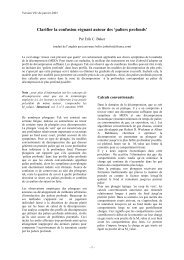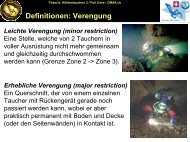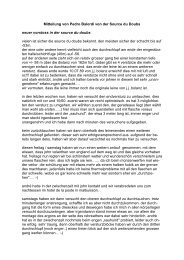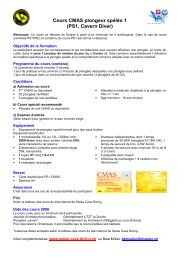cave diving and the nss - bei Swiss-Cave-Diving
cave diving and the nss - bei Swiss-Cave-Diving
cave diving and the nss - bei Swiss-Cave-Diving
Create successful ePaper yourself
Turn your PDF publications into a flip-book with our unique Google optimized e-Paper software.
SLATES 31<br />
Chapter Five<br />
SLATES<br />
Why, you may ask, should <strong>the</strong>re be any question about <strong>the</strong><br />
advisability of using your slate to communicate in an underwater<br />
<strong>cave</strong>? After all, it's a fairly straightforward proposition of whipping<br />
out your slate <strong>and</strong> writing down your message.<br />
The problem is that in <strong>cave</strong> <strong>diving</strong> one must always weigh<br />
advantages against disadvantages. It is certainly true that communication<br />
by slate has a tremendous number of advantages over<br />
light <strong>and</strong> h<strong>and</strong> signals. It uses <strong>the</strong> written word <strong>and</strong> can <strong>the</strong>refore<br />
convey extremely complex messages that cannot be expressed<br />
with sign language. The message is also semi-permanent, <strong>and</strong> can<br />
thus be consulted later on during or after <strong>the</strong> dive. And usually <strong>the</strong><br />
message is fairly unequivocal, although this is not necessarily so.<br />
For example, one of <strong>the</strong> authors was once guarding vehicles <strong>and</strong><br />
o<strong>the</strong>rwise tending <strong>the</strong> surface at a tiny sinkhole while o<strong>the</strong>r divers<br />
were performing some cross-sectional flow measurements in <strong>the</strong><br />
<strong>cave</strong>. Seeing exhaust bubbles appear in <strong>the</strong> sinkhole shaft at <strong>the</strong><br />
appointed time, <strong>the</strong> author lowered down a weighted slate to <strong>the</strong><br />
ten-foot stop, asking if anything was needed, jocularly suggesting<br />
a bottle of bubbly. The slate was sent back up with <strong>the</strong> message<br />
that everything was okay, but could <strong>the</strong> author send down a small<br />
bottle. The author interpreted this to be a jocular response, meaning<br />
a small bottle of bubbly, <strong>and</strong> only found out later that, in fact, a<br />
genuine bottle was <strong>bei</strong>ng requested for biological collecting purposes.<br />
The disadvantages of communicating by slate may be legion.<br />
First of all, it takes time. If <strong>the</strong> message is really urgent, <strong>the</strong>re may<br />
simply not be enough time to write it out, <strong>and</strong> <strong>the</strong> emergency may<br />
well be over before <strong>the</strong> message is. Even if <strong>the</strong> message is not<br />
so urgent, precious minutes may still be lost in <strong>the</strong> process. The<br />
deeper <strong>and</strong> far<strong>the</strong>r in you are, <strong>the</strong> more critical this is.<br />
The use of slates also requires<br />
that <strong>the</strong> divers be stabilized<br />
while engaging in<br />
reading, writing, <strong>and</strong> if it's a<br />
science dive, even arithmetic.<br />
In high flow this may be extremely<br />
difficult, although <strong>the</strong><br />
flow will tend to have <strong>the</strong> advantage<br />
of sweeping away any<br />
silt that is inadvertently kicked<br />
up. Even in a <strong>cave</strong> with a<br />
moderately comfortable floorto-ceiling<br />
height, it is not uncommon<br />
for divers who are<br />
absorbed in <strong>the</strong>ir writing or<br />
reading—especially novice divers—to revert to a vertical trim <strong>and</strong><br />
fin unconsciously in order to remain stable, kicking up <strong>the</strong> bottom<br />
severely. The divers may look up from <strong>the</strong>ir message, only to find<br />
that during <strong>the</strong> course of it, visibility has been reduced from 100<br />
feet to 10 feet.<br />
Because writing takes two h<strong>and</strong>s—one to hold <strong>the</strong> slate, <strong>the</strong><br />
o<strong>the</strong>r to operate <strong>the</strong> pencil—a h<strong>and</strong> is not readily available for<br />
holding onto a wall or projection of <strong>the</strong> <strong>cave</strong>. Sometimes <strong>the</strong> buddy<br />
can actually physically hold onto <strong>the</strong> writer <strong>and</strong> help keep him<br />
stabilized, but in many instances, unless <strong>the</strong> diver has excellent<br />
trim <strong>and</strong> buoyancy control, it will be necessary ei<strong>the</strong>r to become<br />
positive <strong>and</strong> brace against <strong>the</strong> ceiling, or negative <strong>and</strong> rest on <strong>the</strong><br />
floor. The ceiling may not be a practical alternative in a domed<br />
area, <strong>and</strong> one may have to choose between <strong>the</strong> lesser of two evils<br />
by resting as carefully as possible on <strong>the</strong> bottom <strong>and</strong> trying to<br />
minimize silting as best he can.<br />
Because of <strong>the</strong> distraction of <strong>the</strong> reading <strong>and</strong> writing, it can<br />
be easy to get turned around on <strong>the</strong> line, or even to drift away from<br />
it altoge<strong>the</strong>r. The divers may look up from <strong>the</strong>ir slates only to find<br />
that <strong>the</strong>y suddenly aren't sure which way is out, or even where <strong>the</strong><br />
line is, particularly if <strong>the</strong>y have managed to stir up some silt. So<br />
obviously, if you feel you must communicate by slate, it is very<br />
important to take all of <strong>the</strong>se factors into consideration, <strong>and</strong> to make<br />
sure that you are both stable <strong>and</strong> oriented on <strong>the</strong> line.<br />
Ano<strong>the</strong>r problem with <strong>the</strong> slate is that, because of <strong>the</strong> require-















